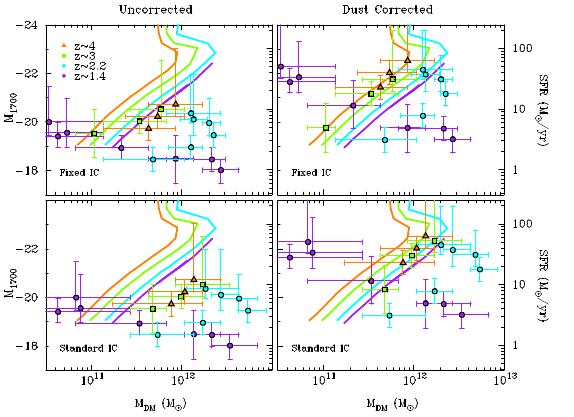
Relation between dark matter halo mass and UV luminosity/SFR (left and right axes) for all redshift samples. The bottom panels correspond to the standard IC fitting procedure and the top panels to the fixed IC fitting procedure. The panels on the left are the observed relations, and the panels on the right are the results after corrections for dust attenuation have been made. The solid lines correspond to the predictions from the Millennium Simulation galaxy models (De Lucia & Blaizot 2007), reduced to median relations. We investigate the luminosity dependent clustering of rest-frame UV selected galaxies at z~4, 3, 2.2, and 1.7 in the Keck Deep Fields (KDFs), which are complete to R = 27 and cover 169 arcmin^2. We find that at z~4 and 3, UV-bright galaxies cluster more strongly than UV-faint ones, but at z~2.2 and 1.7, the UV-bright galaxies are no longer the most strongly clustered. We derive mass estimates for objects in our sample by comparing our measurements to the predicted clustering of dark matter haloes in the Millennium Simulation. From these estimates, we infer relationships between halo mass and star formation rate (SFR), and find that the most massive dark matter haloes in our sample host galaxies with high SFRs (M_1700 < -20, or > 50 M_sun/yr) at z~3 and 4, moderate SFRs (-20<M_1700<-19, or ~20 M_sun/yr) at z~2.2, and lower SFRs (-19<M_1700<-18, or ~2 M_sun/yr) at z~1.7. We believe our measurements may provide a new line of evidence for galaxy downsizing by extending that concept from stellar to halo mass. We also find that the objects with blue UV colors in our sample are much more strongly clustered than those with red UV colors, and we propose that this may be due to the presence of the 2175A dust absorption bump in more massive halos, which contain the older stellar populations and dust needed to produce the feature. The relatively small area covered by the survey means that the absolute values of the correlation lengths and halo masses we derive are heavily dependent on the "integral constraint" correction, but the uniformly deep coverage across a large redshift interval allows us to detect several important trends that are independent of this correction. See the websiade for more details. http://arxiv.org/abs/1106.2146 (SY) |




